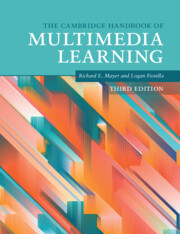Book contents
- The Cambridge Handbook of Multimedia Learning
- The Cambridge Handbook of Multimedia Learning
- Copyright page
- Contents
- Figures
- Tables
- Contributors
- Preface
- Acknowledgments
- Part I Background
- Part II Theoretical Foundations
- Part III Basic Principles of Multimedia Learning
- 11 The Multimedia Principle
- 12 The Multiple Representations Principle in Multimedia Learning
- 13 The Expertise Reversal Principle in Multimedia Learning
- Part IV Principles for Reducing Extraneous Processing in Multimedia Learning
- Part V Principles for Managing Essential Processing in Multimedia Learning
- Part VI Principles Based on Social and Affective Features of Multimedia Learning
- Part VII Principles Based on Generative Activity in Multimedia Learning
- Part VIII Multimedia Learning with Media
- Author Index
- Subject Index
- References
12 - The Multiple Representations Principle in Multimedia Learning
from Part III - Basic Principles of Multimedia Learning
Published online by Cambridge University Press: 19 November 2021
- The Cambridge Handbook of Multimedia Learning
- The Cambridge Handbook of Multimedia Learning
- Copyright page
- Contents
- Figures
- Tables
- Contributors
- Preface
- Acknowledgments
- Part I Background
- Part II Theoretical Foundations
- Part III Basic Principles of Multimedia Learning
- 11 The Multimedia Principle
- 12 The Multiple Representations Principle in Multimedia Learning
- 13 The Expertise Reversal Principle in Multimedia Learning
- Part IV Principles for Reducing Extraneous Processing in Multimedia Learning
- Part V Principles for Managing Essential Processing in Multimedia Learning
- Part VI Principles Based on Social and Affective Features of Multimedia Learning
- Part VII Principles Based on Generative Activity in Multimedia Learning
- Part VIII Multimedia Learning with Media
- Author Index
- Subject Index
- References
Summary
In this chapter, I propose three distinct purposes of multiple representations and suggest that these lead to different design principles and learning activities. Multiple representations can play a complementary role when learners exploit differences in their form and content by switching between and selecting the appropriate representation for the task at hand. Constraining benefits are achieved when learners can profit from the support of a familiar representation to understand a new and complex representation. Finally, if learners abstract across multiple representations, they can construct a deeper understanding of the nature of the representations and the domain they represent. This chapter updates a review of studies that have used multiple representations for these purposes and identifies some of the circumstances that influence the effectiveness of using multiple representations in these ways.
Keywords
Information
- Type
- Chapter
- Information
- The Cambridge Handbook of Multimedia Learning , pp. 158 - 170Publisher: Cambridge University PressPrint publication year: 2021
References
Accessibility standard: Unknown
Why this information is here
This section outlines the accessibility features of this content - including support for screen readers, full keyboard navigation and high-contrast display options. This may not be relevant for you.Accessibility Information
- 4
- Cited by
